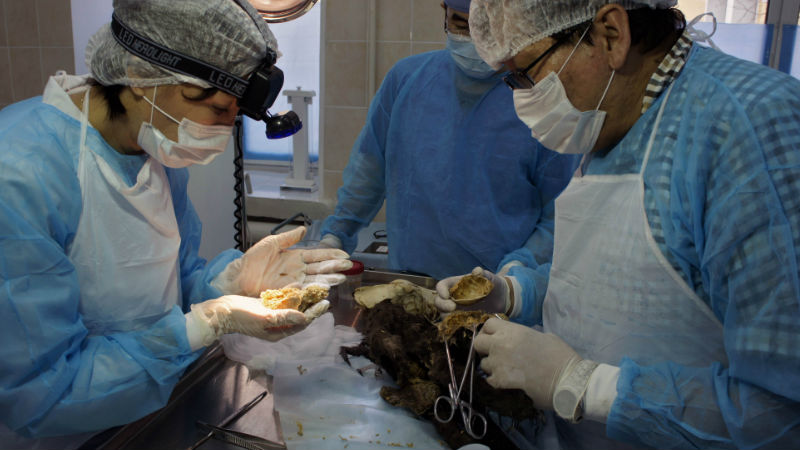Caveman’s best friends? Preserved Ice Age puppies

ICE AGE PUP Russian scientists examine the brains of a frozen puppy, which died 12,460 years ago. A pair of perfectly preserved Ice Age puppies have attracted the attention of scientists worldwide. AFP
MOSCOW—The hunters searching for mammoth tusks were drawn to the steep riverbank by a deposit of ancient bones. To their astonishment, they discovered an Ice Age puppy’s snout peeking out from the permafrost.
Five years later, a pair of puppies perfectly preserved in Russia’s northeast region of Yakutia and dating back 12,460 years has mobilized scientists across the world.
“To find a carnivorous mammal intact with skin, fur and internal organs—this has never happened before in history,” said Sergei Fyodorov, head of exhibitions at the Mammoth Museum of the Northeastern Federal University in the regional capital of Yakutsk.
And the discovery could contribute to the scientific debate over the origin of domesticated dogs.
When the hunters stumbled on the first frozen pup in 2011, they alerted Fyodorov, who flew out to the remote Arctic tundra, 4,700 kilometers from Moscow.
Article continues after this advertisementLast year he returned and found the second puppy close to the same spot, farther down the slope. Both had died when they were about 3 months old.
Article continues after this advertisementThey most likely come from the same litter, said Fyodorov.
Last week he oversaw the removal of the second puppy’s remarkably well-preserved brain—“the first in the world,” he said.
“Puppies are very rare because they have thin bones and delicate skulls,” he said.
The duo have been named the Tumat Dog, after a nearby village.
Fyodorov said a preliminary look at the mammoth remains found at the dig suggested some had been butchered and burned, hinting at the presence of humans. It remains to be seen whether the puppies were domesticated or wild.
The answer can only be determined by reconstructing their genomes, which would take at least a year.
“The lineages of wolves that likely gave rise to dogs have not yet been discovered and it’s possible these puppies could be on that lineage, which would be very exciting,” said evolutionary biologist Greger Larson of the University of Oxford, one of the scientists behind a project to find out when and where dogs became the first domesticated animals.
What makes the dog particularly intriguing is that it managed to become “man’s best friend” even before humans became settled farmers.
It is still unclear whether dogs were domesticated in one place or in several places independently, whether the process started when humans took in cubs or whether wolves themselves gradually drifted to human sites in search of food.
The second puppy’s preserved brain will be compared with that of modern dogs and wolves. Parasites found on its body will be analyzed, as will the contents of its stomach.

“This material is really unique,” said Mietje Germonpre, a paleontologist from the Royal Belgian Institute who partnered up with Fyodorov on the project and came to Yakutsk to oversee the autopsy of the second puppy.
“The fact that soft tissue is preserved will give much more information compared to information that can be obtained from ‘normal’ fossils,” she said, meaning bones and teeth.
Fyodorov lamented the long time it takes to get ancient biological material to suitable labs due to financial constraints, the rugged terrain and red tape, which sometimes means samples reach laboratories only six months later.
“Everyone understands that the tissue of mammoth fauna loses its structure with every passing second, even in the freezer,” he said.
Yakutia’s melting permafrost is likely to yield more treasures in the coming years, he added, saying the number of prehistoric finds has grown “severalfold” in the last decade. AFP